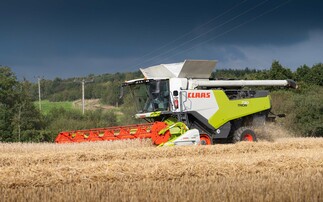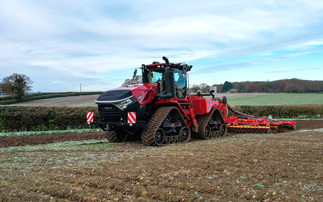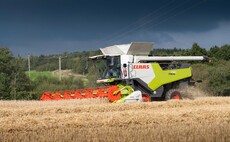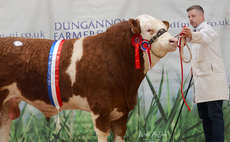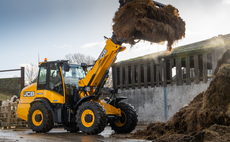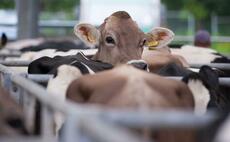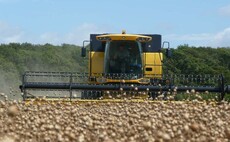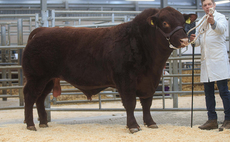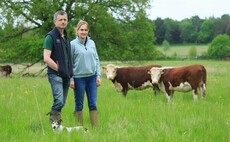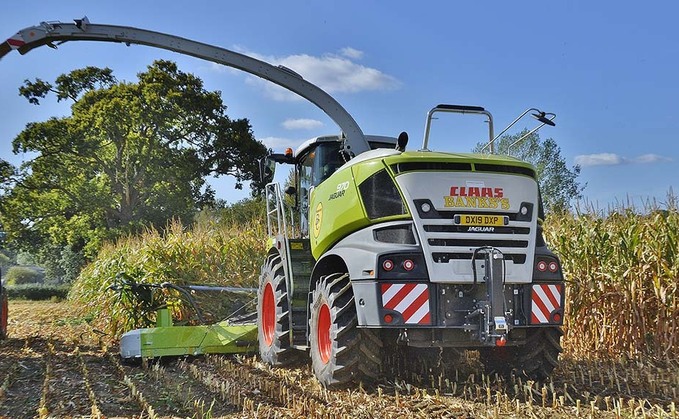
In 2019, Claas announced a host of improvements to the Jaguar 970 self-propelled forage harvester, with new cab controls and a new six-cylinder engine, usurping the previous model's V8. Simon Henley spoke to the firm involved in testing the preproduction model and who is now running two of the new six-pot Jags.
When it comes to forage harvesting, Claas is the king of the self-propelled castle. The Claas Jaguar dominates self-propelled forage harvester (SPFH) sales globally and it is the Jaguar 970 which holds podium position as the company's bestseller.
Two years ago, Claas announced a medley of updates to the design of the venerable Jaguar 900 Series, introducing the new Type 502 generation with more power, upgraded feed and intake housings, a new in-cab control layout, a wider range of adjustment and some serious automation upgrades. They also switched engines, dropping a 24-litre V12 MAN unit into the new range topping 990 model.
Up to this point, the popular 970 model was powered by a 16.1-litre MAN V8 engine which cranked out 775hp. In the new Type-502 this was replaced by a new MAN six-cylinder unit, which at the time of the launch came as a bit of a shock.
Replacing a ground-pounding V8 with a six-cylinder? It sounds like madness. However, using a six-banger actually makes sense, particularly when it is churning out 790hp.
As it turns out, the torque characteristics of the previous MAN V8 would allow the engine to suddenly fade out when you least expected it. In inexperienced hands, this could potentially block the harvester. But that is not the case with the six-cylinder.
With its giant 142mm pistons travelling 170mm on every stroke, the voluminous 16.2-litre MAN unit has been tuned to produce a massive 3,400Nm of torque from 1,600rpm down to 1,350rpm. On paper, that means the big six-cylinder should hang on like a seaside limpet in a changing tide. But is that the case in the field?
The Banks family has been contracting in the counties of Shropshire and Staffordshire for more than 30 years and they have been exclusively using Claas Jaguar harvesters for 18-years. Today, Banks's Agricultural Contractors runs two new Claas Jaguar 970 models, both of which replaced the previous series of V8 machines.
Tom Banks, who founded the company with brothers Roger and Steve, says: "The harvesters are run as two separate teams. Each Jaguar 970 forage harvester is supported by a set of Claas triple mowers, a Claas 12.5-metre rake, five 20T Bailey trailers and a JCB 435S wheeled loader on the clamp.
"Typically we will harvest over 4,000 hectares of grass, 1,000ha of maize and around 250ha of wholecrop during the season. Most of the fodder we are harvesting is for livestock customers, many of whom are large-scale dairy farmers."
At the helm of one of the harvesters is Tom Banks' nephew, Steve Jnr. Raised in the cab of a Claas forage harvester, Steve took over the job as lead harvester driver a couple of years ago and he has plenty to say about the performance of the new Jaguar 970.
He says: "The bottom line is the six-cylinder engine gives you more confidence in the machine's ability. The flexibility of the engine combined with its flat torque curve takes away the worry of blocking the harvester.
"This unit will drop back to 1,400rpm without any concern of it suddenly fading out, whereas the previous V8 would fall flat on its face if you let the revs drop much below 1,700rpm. You had to be careful in heavy crops not to push it too hard, or you would block it up.
"With the new engine, our harvesting output in grass has increased by about 6ha per day. It is the same story in maize, where the output is very similar. On wholecrop, that output advantage falls to maybe 3ha."
Equipped with a Claas DirectDisc 520 wholecrop header, the Jaguar 970 is averaging 13.6kph chopping about 180 tonnes/hour with a 24-knife drum at a length of 12mm. That is cooking on gas by any man's standard, but it is not just the engine which has improved the new 970's performance.
The Class Type 502 models introduced a new armrest control console which integrated the company's familiar C-Motion control lever, borrowed from the Tucano/Lexion combines. Also added was a new Claas Cebis screen which introduced new software and a new logic, programmed to be specific to the Jaguar-900 range.
On-screen information displays can be customised, allowing the operator to prioritise what they want to monitor, for example the chopping cylinder speed or the header height. It is a system which Steve Jnr describes as very easy to use.
"The screen is much easier to navigate. It is more logical and I can quickly prioritise the panes I want to watch. Making an alteration to the operational settings is as simple as touching the required icon on the schematic image of the harvester on the Cebis screen. For example, if I touch the chopping cylinder it will instantly bring up the relevant pane on-screen so I can make the adjustments.
"One feature I do not tend to use, is the Cemos Auto control system. It is very clever and works very well, however it starts to slow the harvester down below the programmed target speed once the engine speed falls below 1,700rpm," he says.
"Driving the harvester manually, I do not need to think about backing off until the engine drops to 1,500rpm. From this perspective, particularly on grass and wholecrop, an experienced driver will get more output if you turn the auto control system off."
Steve Jnr makes driving the new Jaguar 970 look easy. From the outside, the pace at which the trailers are being filled is unapologetically frantic, yet inside the Jaguar's noticeably quiet air-conditioned cab, he remains extremely composed.
With only the slightest movements of his hand and thumb on the C-motion lever, Steve Jnr effortlessly controls the forward speed, header height and the direction of the crop ejecting from the spout into the trailer, which is viewed by a spout camera monitor on the A-pillar.
With the load brimming to the point of overflowing, the next trailer pulls under the spout and the process continues. The important thing to understand at this point, is that while all of this was going on, he continued answering the questions being fired at him by the journalist sitting in the buddy seat beside him.
"When its chopping, the harvester records the acreage covered, the dry matter, the tonnage chopped and the amount of additive applied," he says.
"Once we have finished a job, this data is then put onto paper with a printer and given to the customer.
"The additive system features the low-volume Actisiler applicator, which is far superior to the previous 970. Double walled for insulation, it holds 37 litres and recirculates every five minutes to stop powders settling. On this model, there are applicator nozzles in the feed roller and in the blower housing, which can be used individually or combined. Unfortunately, the main liquid additive tank is still too small at 375 litres."
He adds: "In terms of fuel consumption, the six-cylinder uses about the same amount of fuel as the previous V8 model, but you are getting more output for every litre of fuel it is burning. On grass it will burn more than 800 litres per day. On maize, that will increase to 1,200 litres plus."
The Jaguar 970 is equipped with the Claas Shredlage kernel processor (KP). Described by Steve Jnr as an extremely efficient system, the KP was engaged while the harvester was chopping wholecrop, but it would not be needed at the next farm where the harvester was chopping grass.
"It takes about an hour for one man to ‘wind-out' the KP and set the machine up for grass. What I like about the new Jaguar is when you change headers from wholecrop to grass, you can change all the operational settings, such as the oil flow, using the Cebis screen. It makes the job so much easier," says Steve Jnr.
"The current Jaguar 970 is the best Claas SPFH we have operated to date. It is quiet, comfortable, easy to set up and the new Cebis Screen terminal is excellent; but it is that confidence you get with the performance of the new engine which really clinches the deal for me."

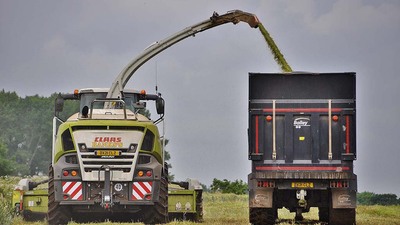
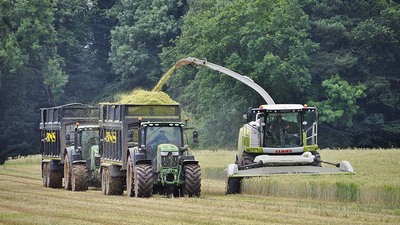
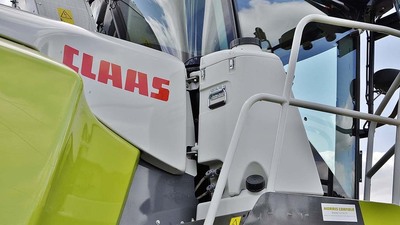
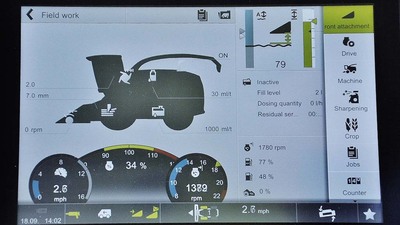
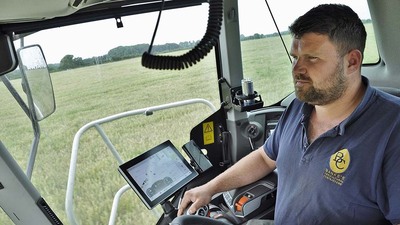
Claas Jaguar 970
Engine: 16.2-litre, six-cylinder, MAN D4276
Power: 790hp
Torque: 3,400Nm
Transmission: Hydrostatic (two-speed)
Knife Drum: Width: 750mm / Diameter: 630mm
Knives: 20/24/28/36/42
Weight: 13,550kg (without attachments)
Length: 6.49 metres










